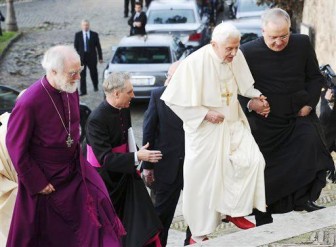ROME (Reuters) – Pope Benedict and the Archbishop of Canterbury, spiritual leader of the world’s Anglicans, met and prayed together yesterday but made only glancing references to the divisions between their Churches.

Archbishop Rowan Williams spoke of the “certain but imperfect” link between the two Christian traditions during his address to the congregation at a joint service at the church of St Gregory the Great near Rome’s Colosseum.
The 84-year-old German pope, who earlier held a private meeting with the archbishop at the Vatican, urged all Christians to “renew their commitment to pray constantly and to work for unity” at the same service.
Past popes and Anglican leaders have been much more outspoken about their differences – over issues ranging from women priests and homosexuality to church doctrine – during their meetings.
The fact that none of them were addressed publicly yesterday will be seen as a sign by many of just how entrenched those differences have become.
The Anglicans broke away from the Catholic Church when King Henry VIII set himself up at the head of the new Church of England in 1534. Pope Benedict made one of his church’s boldest appeals to bring disaffected traditionalist Anglicans back into the fold in 2009 when he said he would set up a parallel hierarchy for them and let them keep some of their traditions inside the Catholic Church.
Williams, spiritual head of the 77-million strong Angli-can Church, was taken aback by the move.
Three months ago, the Rev Jeffrey N Steenson, a married former bishop of the Episcopalian Church, the main branch of Anglicanism in the United States, was chosen to lead those who have converted or want to convert to Catholicism.
Steenson, 59, converted in 2007 and heads a “personal ordinariate”, roughly equivalent to a nationwide diocese, that will oversee ex-Episcopalians. The most prominent recent Anglican convert to Catholicism was former British prime minister Tony Blair, who joined after leaving office in 2007.
The Catholic Church, which accounts for more than half of the world’s 2 billion Christians, has been working since the Second Vatican Council (1962-1965) to try to overcome the splits in Christianity with Anglicans, other Protestants and Orth-odox churches.
The choice of the church for the joint service was symbolically significant because it was from there that the sixth century Pope St Gregory sent out monks to convert the English. The monks included the man who became St Augustine, the first Arch-bishop of Canterbury.









